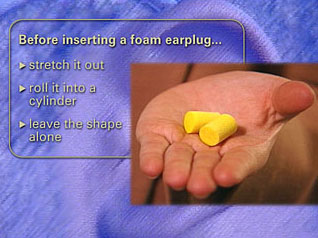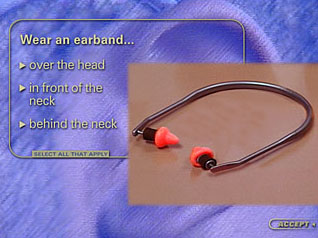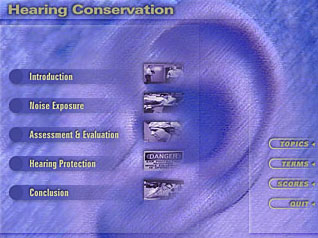Hearing: Hearing Conservation (CLMI)
- Product ID
- clhrcmpg
- Training Time ?
- 27 to 54 minutes
- Language(s)
- English,Spanish,French (Canadian),Dutch (Flemish)
- Video Format
- Standard Definition
- Required Plugins
- MasteryNet Player
- Lesson Interactions
- 10
- Quiz Questions
- 16



Online Hearing Safety Training
We live in a world of sounds and noise. On the job, these sounds and noises can sometimes be loud, annoying, and even dangerous.
Because the human ear can’t block out unwanted or excessive noise, we must take an active role to protect our hearing and prevent permanent hearing loss. A hearing conservation program includes an understanding of how our ears work, what noise levels are considered hazardous, how to test noise levels, and how you can protect employees from hearing damage.
Whenever there’s a chance that employees could be exposed to excessive noise levels, hearing protection and hearing conservation training are important ways to help them protect their hearing on the job.
By training your workers to understand noise exposure hazards and hearing protection, you can reduce the risk of employee hearing loss and improve health in your workplace.
![]() This course is in the Advantage™ format, to read about Advantage™ features click here.
This course is in the Advantage™ format, to read about Advantage™ features click here.

- Install on any SCORM LMS
- Rich multimedia presentation with interactions and quiz
- Print certificate and wallet card
- You have 30 days to complete the course
Training for all employees who work in or around areas where the use of hearing protection is required.
-
Noise Exposure
- How the ear works
- Excessive noise
- Factors affecting hearing
-
Assessment and Evaluation
- Warning signs
- Hearing tests
-
Hearing Protection
- When to use hearing protection
- Using hearing protection
- Earplugs
- Ear bands
- Earmuffs
-
Explain how hearing loss occurs.
- Identify parts of the ear.
- Explain that excessive noise damages hearing by damaging nerve endings in the inner ear.
- Agree that damage to the inner ear creates permanant hearing loss.
-
Determine when noise is excessive.
- Choose the minimum decibel level of excessive noise.
- Agree that excessive noise also occurs outside the workplace.
- List factors affecting hearing loss.
-
Recognize warning signs of hearing damage.
- Select symptoms that indicate a possible hearing loss.
- List ways employers can prevent hearing loss.
- Differentiate between baseline and annual audiograms.
- Explain how baseline audiograms help identify hearing loss.
- State that earbands can be worn three different ways.
-
Use ear protection to prevent hearing damage.
- Cite the general rule of thumb when hearing protection is needed.
- Identify the three types of hearing protection.
- Describe how earplugs fit in the ear canal and form a tight seal.
- State that earbands can be worn three different ways.
- Recognize that earbands are less effective than earplugs.
- List steps to properly use ear muffs.
- Identify possible interferences with earmuffs.
- Identify the proper procedure for inserting a foam earplug.
-
Properly care for hearing protectors.
- Agree that not all earplugs are disposable.
- Describe the cleaning method for reusable earplugs.
© Mastery Technologies, Inc.




